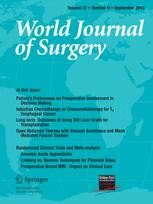WHO Trauma Care Checklist improves care for injured patients according to findings from nine countries
Heidelberg | New York, 2 November 2016
 Injury is responsible for more than 10 percent of the global burden of disease, killing more people each year than HIV, malaria and tuberculosis combined. More than 90 percent of these deaths occur in low- and middle-income countries. Injury is also the leading cause of death in adolescents globally.
Injury is responsible for more than 10 percent of the global burden of disease, killing more people each year than HIV, malaria and tuberculosis combined. More than 90 percent of these deaths occur in low- and middle-income countries. Injury is also the leading cause of death in adolescents globally.
Timely emergency care saves lives and reduces disability, however, there is great global disparity in access to emergency care: if fatality rates from severe injury were the same in low- and middle-income countries as they are in high-income countries, between 1.5 and 2 million lives could be saved every year.
A systematic approach to examining and treating every injured person ensures that life-saving interventions are performed and that no life-threatening conditions are missed. The use of checklists has been shown to improve outcomes for a wide variety of conditions.
The WHO Trauma Care Checklist is a simple tool designed for use in emergency units that emphasizes the key life-saving elements of initial injury care. Developed and validated through a large global collaboration including countries of all income levels, the Trauma Care Checklist is appropriate for use in any emergency care setting and can be easily adapted to local contexts.
A new study reports that implementation of the WHO Trauma Care Checklist Programme at 11 hospitals in 9 countries across all economic levels led to substantial improvements in the consistency of care provided to injured patients as well as being associated with reduced mortality among individuals with the most severe injuries. Countries providing data for this study included Australia, Canada, Cameroon, Colombia, India, Pakistan, Rwanda, Thailand and Viet Nam.
“We were extremely pleased to see that using the Trauma Care Checklist improved care for injured patients across a broad range of countries and care settings” said study leader Dr Charles Mock of the University of Washington. “For example, patients were more than twice as likely to have their cervical spine examined and three times as likely to have a clinical abdominal examination, than before the Checklist was implemented. Moreover, it is very interesting to note that there were improvements in countries at all economic levels.”
This study was primarily intended to assess the quality and consistency of care provided to injured patients, and was not designed to demonstrate differences in mortality. There was no statistically significant mortality reduction among all patients, however, hospitals reported a 49 percent reduction in mortality among the most severely injured patients with multiple injuries. Further studies are needed to determine if this same impact will be seen in larger studies.
“People who are injured in low-resource settings deserve the same quality of care as others,” notes Dr Etienne Krug, WHO Director of the Department for Management of Noncommunicable Diseases, Disability, Violence and Injury Prevention. “With the results of this study, we feel confident to promote this new tool, the Trauma Care Checklist, as part of our efforts to enhance emergency care globally.”
Reference: Lashoher, A. et al. (2016). Implementation of the World Health Organization Trauma Care Checklist Program in 11 Centers Across Multiple Economic Strata: Effect on Care Process Measures. World Journal of Surgery. DOI 10.1007/s00268-016-3759-8
Further Information
WHO Trauma Care Checklist
http://www.who.int/emergencycare/publications/trauma-care-checklist.pdf
Further details of the study, published in the World Journal of Surgery, are available through the SharedIt link at: http://rdcu.be/meCu
About the World Journal of Surgery
Services for Journalists
The full-text article is available as a PDF to journalists on request or can be accessed here.
Contact
Joan Robinson | Springer Nature | Communications
tel +49 6221 487 8130 | joan.robinson@springer.com
